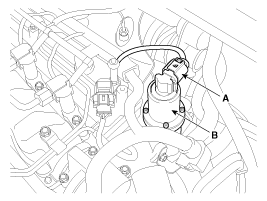Remove the EEGR valve (B) after removing the installation bolts.

Turn ignition switch OFF.
Disconnect the electric EGR control valve connector.
Measure resistance between terminal 1 and 2 of the valve.
Check that the resistance is within the specification.
Specification: Refer to Specification section.
Turn the ignition switch OFF and disconnect the battery (-) cable.
Remove the air duct.
<a href="content.asp?vehicletype=Passenger&mfrcode=KM&area=KME&langcode=ENG&modelid=JD12&modelyr=2013&mmctype=en&mmcid=349&group=SHOP&pdftype=&cat1=2013+%3E+D+1%2E4+TCI%2DU2&ec=&firstnodedesc=Engine+Mechanical+System&sitinfolist=12%5E1235%5E12350100%5Enone%5E801%5E1%5EENG%5EKM%5EJD12%5E2013%5Een%5E348%5Enone%5Enone%5Enone%5ESHOP%5E%24" target="_blank">(Refer to Engine Mechanical System - "Air Cleaner")</a>
Disconnect the EEGR valve connector (A).
Remove the EEGR valve (B) after removing the installation bolts.

Install the component with the specified torques.
Note that internal damage may occur when the component is dropped. In this case, use it after inspecting.
Installation is reverse of removal.
Electric EGR control valve installation bolt:
21.6 ~ 27.5 N.m (2.2 ~ 2.8 kgf.m, 15.9 ~ 20.3 lb-ft)
After replacing the Electric EGR valve, MUST perform the "ECU Initialization" procedure.
Otherwise trouble related with engine performance or emission control may occur until ECM learning about the component is over.
Turn ignition switch OFF.
Connect a GDS to Data Link Connector (DLC).
Turn ignition switch ON.
Select "Vehicle, Model year, Engine, System".
Select "Vehicle S/W Management".
Select "ECU Initialization".
Select "E-EGR valve Change".
Perform the procedure in accordance with the message.
